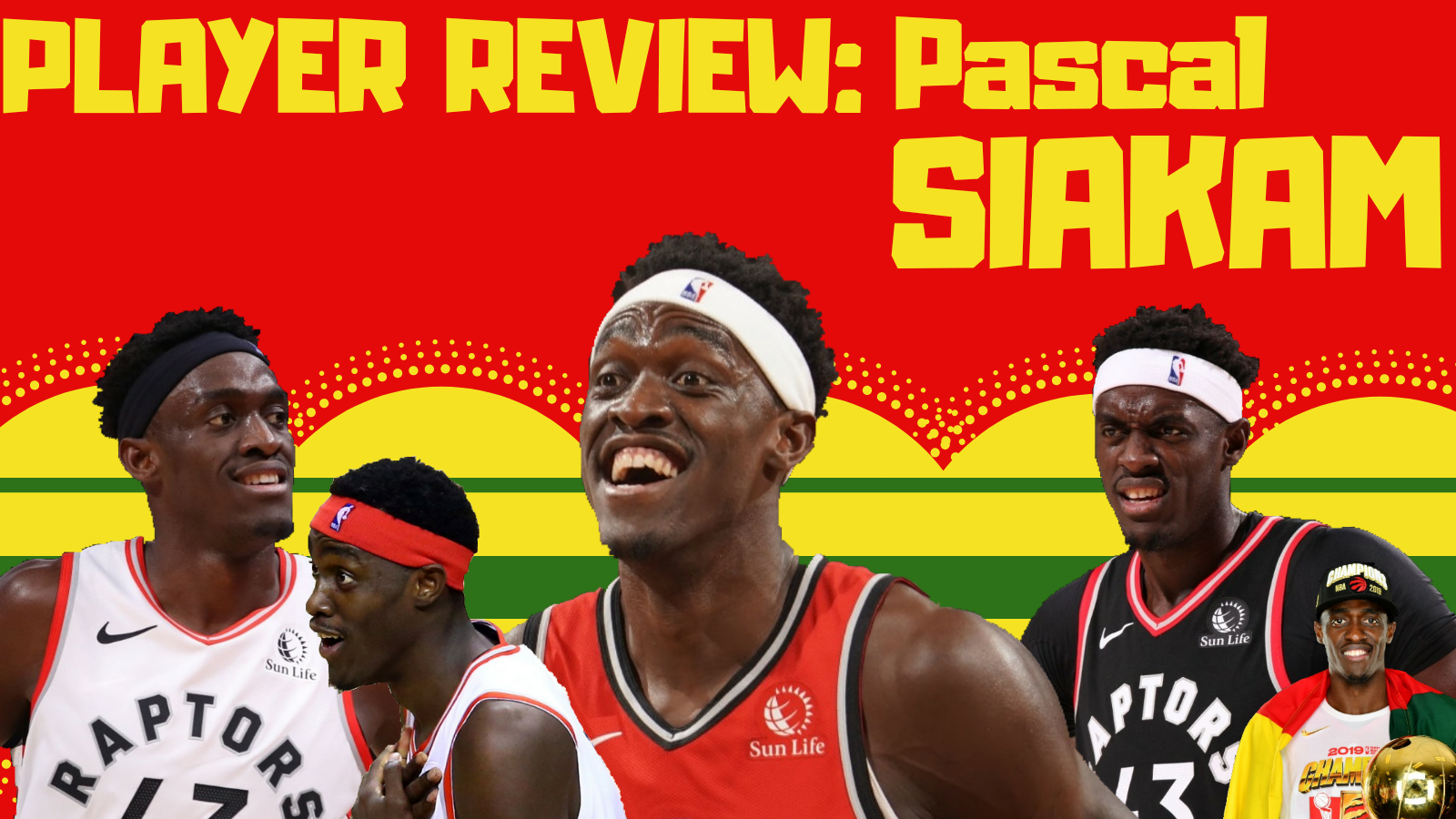The 2019-20 NBA season felt long for a lot of people in and around the league, but perhaps no one experienced the longevity — and the ups and downs that came with it — than Toronto Raptors’ forward Pascal Siakam.
Siakam had far and away the best season of his four-year NBA career, averaging 22.9 points, 7.3 rebounds, and 3.5 assists to go along with 1.0 steals and 0.9 blocks per game, all career-highs. Siakam became a first-time All-Star and was named to the All-NBA Second-Team, essentially being named the fourth-best forward in the league behind only LeBron James, Giannis Antetokounmpo, and Kawhi Leonard.
And yet, Siakam struggled mightily in the NBA bubble and throughout the Raptors shorter-than-expected playoff run, and the regular season optimism surrounding Siakam quickly turned against him once the Raptors were eliminated.
We in Toronto have a bad habit of focusing on the negatives instead of the positives. In the case of Raptors’ fans, perhaps it’s because we fear history will repeat itself and, in Siakam, we see stars of Raptors past who could never get the team over the hump. A lot of people have already made the DeMar DeRozan comparison, theorizing that Siakam will never become a No. 1 option on an NBA Finals team and that this version of the Raptors isn’t built for the playoffs. There have even been suggestions that the Raptors trade Siakam (shame on you all).
But I’m here to argue that judging Siakam based solely on his play in the bubble would be unfair and unwise because a bubble in the midst of a pandemic (after not having played ball for three months) is not representative of him as a basketball player. Furthermore, assuming that Siakam has reached his peak simply because he is 26 years old would be to ignore the unlikely strides he has made in each of the past three seasons, where he went from a 7-point per game bench scorer to the No. 1 option on one of the best and most entertaining teams in Raptors franchise history.
Yes, Siakam played poorly in the bubble. He averaged only 17.0 points in the playoffs, which was below his average of 19.0 points from the 2019 playoffs. He also saw his true shooting percentage drop from 55.4 to 46.2 despite his usage (the percentage of plays he was directly involved in) also dropping from 28.1 to 23.7 in the playoffs.
Most glaringly, perhaps, was Siakam’s three-point shot falling off the face of the Earth: After shooting the ball really well throughout the regular season, shooting 35.9 percent from three on 6.1 attempts per game, Siakam shot just 18.9 percent from three in the playoffs. A lot of fans were demanding he stop shooting threes and start taking the ball to the basket, but one of the reasons Siakam was so good during the season was because his three-point shot opened up the game for him and his teammates by allowing him to more easily penetrate the paint. It’s concerning that Siakam’s three-point shot has failed him in two consecutive postseasons, but the fact that he is becoming so comfortable shooting it in all situations is a huge first step.
We kept waiting for Siakam to find his rhythm in the bubble, which was why Siakam’s performance in Game 7 of the Boston Celtics’ series was so disappointing, scoring just 13 points along with five uncharacteristic turnovers.
But there were also bright spots from Siakam in the bubble, including his inspired defense and improved rebounding.
It’s not a stretch to say Siakam played the best defense of his career against the Boston Celtics, constantly chasing people off the three-point line or being in the right position to protect the basket against a fast and athletic team. He also improved as a rebounder, which was essential in small-ball lineups, averaging a career-high 7.5 rebounds throughout the playoffs. His defense is one of the reasons the Raptors had the No. 1 defensive rating (104.9) in the playoffs and why they lasted 7 games against the Celtics despite Siakam never finding his rhythm offensively, and it’s part of the reason Siakam finished the series with a net rating of -4.8, second only to Kyle Lowry among Raptors regulars.
In fact, you could argue that Toronto’s defensive identity this entire season was built around Siakam more than anyone else. Although Marc Gasol (who only played 44 games) and OG Anunoby (who is best as an on-ball defender) got most of the praise for Toronto’s No. 2 ranked defense, no one was more essential to their swarming identity than Siakam, who contested more three-pointers anyone in the league.
Siakam did take a small step back as an on-ball defender this season, but that was mostly because he needed to preserve energy in order to be the No. 1 guy on offense, and he proved in the playoffs that he could still stay in front of fast, athletic wings like Jason Tatum and Jaylen Brown when need be. But his team defense is what allowed the Raptors to constantly switch up coverages and always play with immense pressure.
As Mike Prada wrote in a story for SB Nation titled “How the Raptors’ defense is making other teams see ghosts”:
“Every Raptor plays an instrument, but Pascal Siakam is the orchestrator of the Raptors’ closeout crescendo. He is so fast, long, and versatile that he spooks potential shooters the second he surges toward them. Per NBA.com tracking data, Siakam contests six three-point attempts per game all by himself, the most among players with at least 25 games played by a wide margin. Because he can guard all five positions effectively, opponents never know exactly where he might be on a given possession. And because the Raptors’ system is so well drilled at rotating down early to stop drives to the basket, Siakam is free to run at shooters all over the court without worrying about getting beat on drives.”
It’s not common for a guy to play that big of a role in the defense in his first year as the primary offensive option, but Siakam did both jobs so well in just his fourth NBA season that he and the Raptors shocked the league and finished the season with the second-best record in the NBA. He is the biggest reason that the Raptors became unlikely contenders last season and will be contenders again this upcoming season.
Offensively, Siakam was a shell of himself in the bubble, but considering he took over three months off from even from playing basketball during quarantine, it’s understandable why he never found his rhythm. Yes, you expect your best players to show up for you in big moments, regardless of the circumstances of where those moments take place. But Siakam’s play in the bubble simply doesn’t represent him as a player. Just watch him shred the Utah Jazz’s 13th ranked defense in the Raptors final game before the COVID-stoppage:
https://www.youtube.com/watch?v=lIIIKFjbScQ&ab_channel=Z.Highlights
That is a different player from the one we saw in Orlando, and there is no reason to think he won’t return next season even more improved after an offseason where he will have a chance to further develop his game.
I already mentioned Siakam’s improved three-point shooting, but I can’t stress enough how important it is that Siakam develops a reliable outside shot in order to maximize his offensive potential, especially because he is so close. The three-point shot spaces the floor for his teammates and makes life easier when Siakam has the ball in his hands, as defenders guard him closer to the three-point line, making it easier for Siakam to use his excellent first step to drive past his man and force the defense to collapse into the paint.
Pascal busting his ass in the gym.. he’s coming for that MVP pic.twitter.com/looANxktKz
— Josh❔ (@PascalMv) October 6, 2020
Siakam also made huge strides in terms of playmaking this season, averaging a career-high 3.5 assists and assisting on 16.4 percent of his teammates’ baskets while on the floor. But Siakam also coughed up a career-high 2.5 turnovers per game, and he’ll need to tighten his handle and read the floor a bit quicker if he is going to clean those up.
We did see him make improvements on his reads the longer the regular season went on, not just passing out of double-teams but making the more difficult pass to create an open shot right away. He went from making this pass to making this one. It’s important that he keeps improving his playmaking because teams are going to continue double-teaming him in the post, as Siakam is lethal near the rim, shooting 62.3 percent from within five feet of the basket before the league shut down and 67.1 percent the season prior.
One thing Siakam struggled with this season — perhaps the biggest thing that sets him apart from a guy like Kawhi Leonard — is his midrange scoring. On the season, Siakam shot just over 30 percent between 10 feet and the three-point line, after shooting close to 45 percent last season. Opposing teams know that Siakam is usually either going to shoot the three or drive all the way to the basket, making him much easier to defend than someone like Leonard or Jimmy Butler, who use their mid-range game to stoke fear into the opponent, shooting if the center drops to the rim or using the shot as a decoy to pass to a cutter.
To say Pascal Siakam has hit his offensive prime means you haven’t been watching a lot of Pascal Siakam over the past few years. He has fundamentally changed from a seven-point per game scorer to a 23-point per game scorer in less than three years. He went from someone who could only make the most basic of passes to someone who looks comfortable handling in the pick-and-roll or passing out of double teams. He went from an athletic defender to one who you could largely build your defense around. He is relatively new to basketball and has gotten significantly better every year. Assuming he has reached his ceiling simply because he is 26 years old would be to assume that he is cut from the same cloth as other NBA stars. He. Is. Built. Different.
There are undoubtedly aspects of Siakam’s game that he needs to work on in order to be an effective No. 1 option in the playoffs, when a team has the opportunity to game-plan for him and take away his greatest strengths (spin move). For example, his handle needs to get tighter in order for him to be more comfortable facing playoff pressure. An improved handle would help him create more space for his jumpers — especially in the mid-range, as he already looks comfortable shooting the three off the dribble — and also in order to keep the dribble alive for longer in order to find teammates instead of killing the play. Siakam should also aim to get stronger in order to draw more fouls (he averaged 4.0 free throws per game) and finish through contact, something Jimmy Butler recently focused on.
It would be unfair to judge Siakam based solely on a bubble in the middle of a pandemic. That I even have to write those words seems obvious, but sports fans are ruthless, and some of them need to hear it.
Instead, let’s judge Siakam by his response to experiencing adversity for the first time in his NBA career. He failed to do his job against the Celtics — he knows that and has said as much — but he has the opportunity to come back next year better than ever, just like he has in each of his seasons as a Raptor.
Let’s give him the chance to do that before we write him off.



